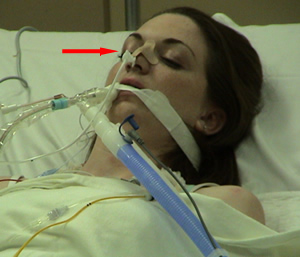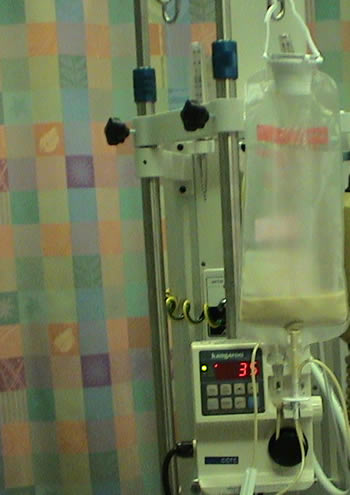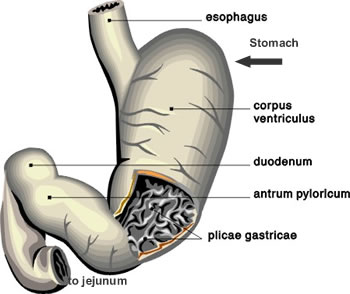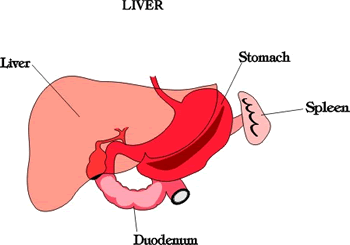|
Patients need adequate nutrition to recover from any illness. Patients who are critically ill have high nutritional requirements and can become malnourished very quickly. We know from research findings that early feeding is important to patient outcome. The nutritional needs of all patients are reviewed daily and feeding is initiated as soon as possible, usually within the first day of admission. The best way to feed a patient is using their own gastrointestinal tract (stomach and bowel). Feeding by the gastrointestinal tract is called "enteral feeding". We also refer to this as feeding through the gut. Because patients cannot swallow food if they have a breathing tube in their throat, they are fed through a feeding tube. A specially designed solution that contains the nutrients the patient will need to recover is provided. Most feeding tubes are inserted into the nose or the mouth, and the tube is advanced into the stomach (Image 1). The feeds are mixed in a sterile bag and given as a steady infusion that runs 24 hours per day. A pump similar to an intravenous pump is used to deliver the feeding solution (Image 2). When patients are critically ill, their gastrointestinal may not work properly. Food in the stomach may not empty into the bowel the way that it should. Food that does not move out of the stomach can regurgitate into the lung. This is called aspiration. Aspiration is a serious complication that can cause pneumonia. Food that does not leave the stomach and enter the bowel will not meet the patient's nutritional requirements. Feeding tubes that are located in the small bowel reduce the risk for aspiration and promote more successful feeding. They are called Small Bowel Feeding Tubes. When a feeding tube is inserted through the nose or mouth, the nurse or physician will attempt to manipulate the tube in a way that encourages it to pass from the stomach and into the bowel. If the feeding tube does not advance into the small bowel and the patient has difficulty tolerating their feeds, the feeding tube can be inserted through a small puncture in the abdominal wall. A puncture through the skin is called "percutaneous" ("cutaneous" means skin, "per" means through). A feeding tube inserted through a puncture wound is called a Percutaneous feeding tube. Tubes that end in the stomach are called "gastric" tubes or G tubes. The stomach empties toward the right side and into the small bowel. The initial segment of the small bowel (or small intestine) is called the duodenum. A tube that ends in the duodenum is called a duodenal tube. The next section of the small bowel is the jejunum. A tube inserted into the jejunum is called a "J" tube or jejunal tube. If a tube is inserted through the nose, it is called a "nasal" tube. A stomach tube that is inserted through the nose is called a nasogastric tube or NG. Tubes inserted through the mouth are called "oral" tubes. An orogastric tube or OG is a stomach tube that is inserted through the mouth. An OJ is a small bowel feeding tube (ending in the Jejunum) that was inserted through the mouth. Finally, a tube inserted through a puncture site can be identified by the end of the word. A puncture hole is called a "stoma" or "ostomy". A stomach tube that is inserted through a puncture is called as gastrostomy. A jejunal tube inserted through a puncture is a jejunostomy. Larger tubes can also be inserted into the stomach to drain the stomach contents. This is called gastric drainage. This is done to promote patient comfort and prevent vomiting or aspiration. These can be connected to low suction (or low vacuum), to help keep the stomach empty. Gastric suction tubes and small bowel feeding tubes can be used at the same time. The gastric tube will keep the stomach empty while the small bowel feeding tube delivers food below the stomach. If, despite efforts to promote successful enteral feeding, the patient cannot tolerate being fed by their gastrointestinal tract, patients may need to be fed by a special intravenous formula called Total Parenteral Nutrition or TPN. TPN contains carbohydrates, fats and protein. They are provided in two concentrations of a sugar preparation (called dextrose). The lower concentration of dextrose is called Peripheral TPN (PTPN). It can safely be administered into small peripheral veins, however, it may not provide enough calories to meet the needs of a critically ill patient. Central TPN (CTPN) has a higher concentration of dextrose, therefore, it provides more calories. The high concentration of dextrose is irritating to the blood vessels and must be given into a large central vein. |
Image 1: Nasally inserted feeding tube. |
|
Image 2: Enteral feeding solution being administered by feeding pump. |
|
|
|
|
|
Image 3: Stomach empties into duodenum. Duodenum becomes jejunum. |
Image 4: Stomach empties to right. Duodenum located below liver. |
|
|
|






